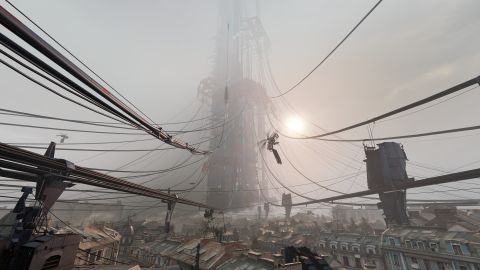Our Verdict
With old friends, new enemies, and an exciting story, revisiting City 17 in VR is a thrill in Half-Life: Alyx.
PC Gamer's got your back
What is it? Valve's return to Half-Life, only in VR.
Expect to pay: $60/£46.49 (Free for Index owners)
Developer: Valve
Publisher: Valve
Reviewed on: i7-9700K @3.60GHz, 16 GB, Nvidia GeForce RTX 2080 8GB, HTC Vive Pro/Valve Index
Multiplayer? No
Link: Official Site
I played the final three hours of Half-Life: Alyx in a single session. Before Alyx, I never used VR for more than 30 minutes at a time. I don't get motion sick but I do get generally tired of VR. Tired of having a hunk of plastic strapped to my face, of having to stand and stoop and reach awkwardly around, of not being able to check my phone or have a sip of coffee. But I didn't take a break, or even want to, during the final chapters of Half-Life: Alyx. I wasn't tired. I was completely enthralled and unwilling to stop playing.
When I played through the ending (no spoilers here, but trust me, you'll want to keep your VR headset on through the credits), I reloaded my last autosave and played through the ending a second time. And then I went back to the beginning of the game and started playing again. I didn't have much doubt Half-Life: Alyx would be a great VR experience—Valve makes its own VR headset and software, after all. But I was skeptical it could also be a great, proper Half-Life game, and I was thrilled to discover it really is. While it's sandwiched between the events of Half-Life 1 and Half-Life 2 the repercussions of its story extend well into whatever future there is for the Half-Life series, and its technical accomplishments will leave other developers, once again, struggling to keep up.
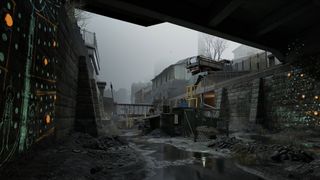
On a rail
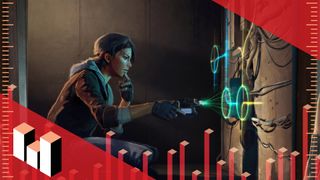
Looking for a VR headset for Half-Life: Alyx? Wondering if your GPU is up to the challenge? We've got you covered. Here's the the best GPU and VR headset for Half-Life: Alyx.
Five years before the events of Half-Life 2, Alyx Vance is performing surveillance and recon in the Combine-controlled City 17. It's immediately engaging to be back in City 17 again, so familiar yet so much more impressive in VR, an environment I don't need to just look at to admire but one I can actually run my virtual fingertips across and crane my neck back to take in fully. When a city scanner takes my picture I instinctively hold my hands up against its blinding camera flash. Combine Metro Cops seem larger than life because they're now actually life-size. I've seen Striders before but I've never had one step over me in VR as I stared up at it, utterly dumbfounded, watching it sink its massive feet into the side of a building, using the crumbling masonry as a step to walk itself up to a rooftop. The opening minutes, and at plenty of times during the entire game, I just had to stop, stand still, and take it all in.
The attention to detail is obvious not just in how the world looks but in the ways you can interact with it. Alyx's disembodied hands react wonderfully to each object in the world, and it's hard not to just stand there admiring the way my virtual fingers close in different ways depending on what I'm holding: curling around a bottle, gently clasping an iron railing, holding a discarded cigarette butt between my thumb and forefinger, gripping an empty water jug by the handle, pulling up the antenna and then gently twisting the tuning knob on a radio. Even discovering I can pick up a marker to scrawl something on a dirty window pane, and then realizing I can use an eraser to wipe it off, is delightful. You could easily spend 15 minutes just messing around with the physical objects in the introduction, and that's exactly what I did.
Even while dallying, it's a surprisingly brief beginning introduction when compared with Half-Life's opening train ride and Half-Life 2's similarly lengthy stroll through City 17. While there is a jaunt through the city streets and a train ride at the start of Half-Life: Alyx, you'll still pretty quickly be holding your first gun and wearing a pair of gravity gloves (or as their inventor Russell likes to call them, Russells) which let you point to an object and yank it through the air and into your hand with a simple and satisfying flick of the wrist.
How many objects did I Force-pull to my hand over the course of Half-Life: Alyx? Hundreds? A thousand? I don't know, but it never once got old.
After the intro you descend into City 17's quarantine zone, a murky labyrinth closed off by walls within the walls of City 17, where most of the game takes place. Your father, Eli, has been captured by the Combine and you're trying to intercept the train he's on by making your way through a Xen infestation that has filled metro tunnels, dark sewers, and basements of crumbling buildings.
Apprehension
The Half-Life series, especially the original, has always been as much about horror as about action, and that horror was often gross. Plump, fleshy headcrabs leaping at your face from darkened air ducts, shambling zombies with bloody, elongated claws and gaping midsections suddenly lurching to life, the gonarch's massive and pendulous testacles swinging as it gallops after you, the giant fetus-like body and swollen cranium of the Nihilanth. Disgusting.
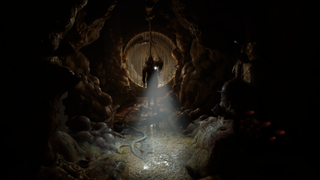
Barnacles with their sticky, dangling tongues belch and barf human remains directly onto me when they expire.
Here in VR the graphic grossness increases by at least a factor of 10. Barnacles with their sticky, dangling tongues belch and barf human remains directly onto me when they expire, giving me another good reason to avoid standing under them. Apartment walls are covered with pulsating tendrils and toothy alien blossoms that gibber and snap at my fingertips if I hover too close. Shiny gas sacks cling to the walls, swelling and inflating when I approach until they rupture and spew noxious particles into the air. Corpses sit upright at desks, dangle from holes in ceilings, and lean through windows, silently daring me to nudge them out of the way or collect ammo clips and health syringes from their blood-blackened bodies.
Even the act of healing is gross, as I insert a glass cylinder containing a living alien grub into a wall-mounted health station and watch as it's crushed into a bilious liquid just inches from my face, followed by skittering needles jabbing into the backs of my fingers as the machine knits health back into my veins. Not to mention the lengthy stealth sequence where I'm stalked by a creature who insta-kills me by vomiting gallons of black slime directly onto my face. While the grossness feels overdone at times, it's also pretty neat that headcrabs and barnacles and other creatures I've been shooting at since 1998 are now freshly creepy and repulsive in VR.
Progressing through the quarantine zone is slow work, both due to the nature of movement in VR, the need to search through each room for spare ammo and resin (a resource you can use to upgrade your guns) and the unsettling, spooky, occasionally pitch-black environment. Thankfully, jump scares are downright restrained so they never feel cheap. Sure, I yelled when I opened a kitchen cabinet and a dead headcrab rolled onto me, and I jumped when a zombie thumped a hand against a window as I walked by, but these sudden scares don't happen as often as they could and the horror strikes a fair balance between tension, dread, and startling "Oh shit!" moments.
Surface tension
Thankfully the second half of the game opens up into more dynamic combat encounters.
As in the original Half-Life, there are those precious moments where you're able to ascend from the oppressive sewers and tunnels and get to stand outside under the sky again, feeling relief, basking in the extra space where the walls are dozens of yards away instead of within arm's reach. It's often just a tease, a brief respite to walk around outside the claustrophobic ceilings and corridors for just a few minutes, until you discover the only way to progress is back down some bleak set of concrete steps as the game once again pushes you into the gloom.
And as the first six or seven hours slowly passed I became a bit impatient to move onto a different type of environment, to spend some real quality time above ground. Despite some exciting new enemy types spicing things up in the quarantine zone, I did sometimes grow weary while putting a few more bullets into a few more headcrabs as I traveled through yet another gross, creepy sewer.
Thankfully the second half of the game opens up into the more dynamic types of combat encounters I loved from earlier Half-Life games. Antlions are also infesting the city and they're much more fun to fight than headcrabs and zombies—faster, alarmingly huge, and much more directly aggressive. To stop them you'll need to target their limbs and abdomens, which isn't easy when a pack of them are scuttling toward you and you're fumbling to reload one of your guns. Even an antlion with a single leg still attached will drag itself doggedly toward you, doing their best impression of Starship Troopers' Arachnids.
Fights are usually pretty brief, but they're still extremely fun, chaotic, and challenging.
Combine soldiers begin showing up more often in the second half of the game, too, both to fight you and the antlions. After hours of slowly creeping through the early sewers and basements you can finally freely navigate the environment, take cover, displace. When you come across a fight already in progress, you have time to plan your assault by using a grenade or explosive barrel to conserve ammo. The nature of VR movement means you're not exactly strafing around at full speed, and these fights are usually pretty brief, but they're still extremely fun, chaotic, and challenging.
Blast pit
Unlike Gordon Freeman, Alyx Vance does not have a massive arsenal to deal with her enemies. In addition to a standard pistol you'll eventually acquire a one-handed shotgun and a Combine pulse pistol. The guns each have a different method of reloading which makes them enjoyably distinct.
Eject a spent mag from your pistol, grab another from your backpack or use your gravity gloves to yank one into your hand, slap it home, and click the slide into place. The shotgun breaks open allowing you to shove in fresh shells two before snapping it closed again with an quick hand movement. The Combine pulse pistol loads ammo pods from a side feeder and a quick sideways flip of the wrist snaps it shut again. It's not all that different than reloading guns in the other VR shooters I've played, but the actions remain satisfying to perform, especially during a mad scramble as antlions scuttle toward you or Combine soldiers try to flank your position.
Reloading in the dark is another thing altogether, because it you're using the hand your flashlight is mounted on to reach over your shoulder into your backpack—which means you briefly can't see whatever monster is lurching toward you. Using two hands to move an obstruction or lift a heavy roll-up door requires putting your gun away, and sometimes there's something waiting on the other side of that door. The slow pace of Half-Life: Alyx allows you to build up a bit of muscle memory for performing all these actions, but it also delights in testing you. I failed that test plenty of times, including once where I accidentally switched from my gun to an empty hand and pointed at a zombie instead of shooting it, and the time I tried to load a sardine can into my pistol because I thought I'd gravity-grabbed a fresh mag off the floor.
Upgrades (purchased with resin) make your weapons more useful and almost as importantly, make them look a lot cooler. Adding an extra ammo capacity module to the pulse pistol gives it a gnarly, dangerous look and lets you engage in long, cathartic bursts of fire after treating bullets and shotgun shells as precious resources for the early part of the game. The pistol's reflex sight and laser dot will highlight living headcrabs and spore-sacs, as well as weak points on enemies that can be targeted for an explosive shot. The shotgun can be modified into a grenade launcher, letting you clip your 'nade to the front of the gun and then slide it into place with a new handle, another fun and tactile interaction.
Your other gadget is a multi-tool, used to solve 3D puzzles attached to Combine supply stashes, weapons fabricators, and especially for rerouting power. Most of the puzzles are fairly basic and grow more challenging as you progress, but the power puzzles are probably the most satisfying, as you use the tool to follow electrical cables first through walls, then eventually up to ceilings, around corners, down hallways, and through entire rooms. It really involves you in the level geometry as you hunt for the power junctions, sometimes having to open cabinets or stand on top of crates to get close enough to the power cables buried in the walls.
Interlopers
Half-Life: Alyx introduces some new characters alongside its familiar ones. Russell (voiced by Rhys Darby) fills in for the absent Dr. Kleiner nicely, delivering a mix of jokes, information, and warm commentary on your plight over a headset. Eli (now played by James Moses Black) is great as a dad not only concerned for his daughter but also supremely confident in her abilities.
And of course there's Alyx herself (now voiced by Ozioma Akagha) who as in Half-Life 2 remains a source of humor, determination, and empathy. She immediately feels comfortable to inhabit, having spent so much time with her in Half-Life 2 and the following episodes, and it's wonderful to not just spend time with her but actually walk in her shoes. I wondered if it would feel odd to play a Half-Life game with a voiced protagonist, but it's not. Having heard Alyx talk so much in Half-Life 2, it feels completely natural for her to talk now.
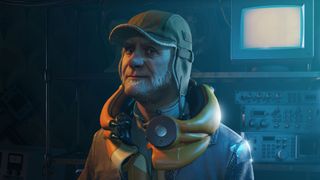
Despite the excellent cast, Half-Life: Alyx feels a bit more solitary than the previous games. Throughout our adventure in the original Half-Life we had constant encounters with nerdy scientists and gun-toting Barneys that made the Black Mesa Complex feel more populated. In Half-Life 2 there were a number of characters we could spend time with, from scientists to resistance members to, you know, Alyx herself. It surprised me that there aren't many face-to-face encounters in Half-Life: Alyx, which is a bit of a shame since it's so powerful in VR to share a space with another character, to really feel them looking into your eyes and sharing your space. I wish there was a bit more of it in Half-Life: Alyx.
What Half-Life: Alyx lacks in close-up interactions it makes up for in the sheer thrill of being in a fresh Half-Life game after all these years. When conversation turns from the matters at hand to Half-Life history, to talk of the Black Mesa incident, it's a bit of a thrill. I remember that! I was there! When the topic of Gordon Freeman comes up, it's an electrifying feeling. Hey, I've heard of him. I was him! And as the mission turns from the rescue of Eli Vance to the investigation of a dark secret held by the Combine, the intrigue and excitement propelled me forward through the rest of the game, eager to have my questions answered, to uncover new mysteries, to discover what was being added to the lore and history of the Half-Life narrative that I've enjoyed for decades. I wasn't disappointed.
Power up
I played through Half-Life: Alyx using the HTC Vive Pro, and then spent a few more hours replaying it with a Valve Index. (It's worth mentioning that the version I played was still being patched on a daily basis by Valve to improve performance and fix bugs.) Apart from a single crash to desktop, and one quicksave that wouldn't reload, I didn't experience much in the way of technical issues. On a few occasions when starting a game my framerate was too choppy to play comfortably, though rebooting the game always fixed the issue.
Both provided a smooth experience with all performance settings on high with my Nvidia GeForce RTX 2080. The Vive Pro controllers worked well with Alyx and are easier (for me) to manage than the Index controllers. The Index controllers are a bit more fun since it individually tracks all five fingers, though I find easily reaching all the buttons is a bit trickier to manage than on the Vive. You can read our comprehensive performance analysis, and see what we think are the best GPU and VR headset for Half-Life: Alyx here.
I recommend saving your game often—while the autosave system feels generous, it once saved while I was in immediate peril and reloading that save resulted in being unavoidably killed. In a throwback to earlier Half-Life games, loading times between levels (my game was installed on a HDD) can sometimes drag on, and they feel longer when you're waiting in VR and can't do anything besides stand there, staring and waiting.
Unforseen consequences
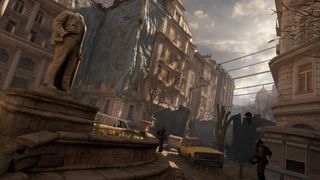
Half-Life: Alyx took me roughly 13 hours to complete, and while the slow and measured pace and claustrophobic setting of the first half felt occasionally stifling, the second half flew by as the intrigue of the story took hold and the combat got far more exciting, varied, and fast-paced.
The ending is, frankly, wonderful, surprising, exciting, not to mention more than a bit puzzling when you really stop to think about it. I'm eager to see Half-Life fans react and dissect and discuss it, as I'm sure they will for months afterwards, and it makes all sorts of follow-ups to Half-Life: Alyx seem possible. I just fervently hope whatever that follow-up is, that Valve (please, please) doesn't make us wait another 13 years for it.
With old friends, new enemies, and an exciting story, revisiting City 17 in VR is a thrill in Half-Life: Alyx.

Chris started playing PC games in the 1980s, started writing about them in the early 2000s, and (finally) started getting paid to write about them in the late 2000s. Following a few years as a regular freelancer, PC Gamer hired him in 2014, probably so he'd stop emailing them asking for more work. Chris has a love-hate relationship with survival games and an unhealthy fascination with the inner lives of NPCs. He's also a fan of offbeat simulation games, mods, and ignoring storylines in RPGs so he can make up his own.

Slay the Spire co-creator advises that 'taking risks is actually the least risky thing you can do,' arguing for the appeal of 'hyper-engaging' games

BlizzCon 2024 isn't happening

'Marketing's dead, and I can back this s**t up': Larian's publishing director says players 'just want to be spoken to, and they don't want to be bamboozled'
